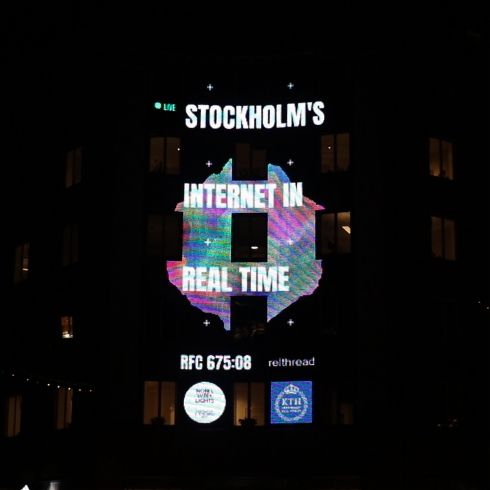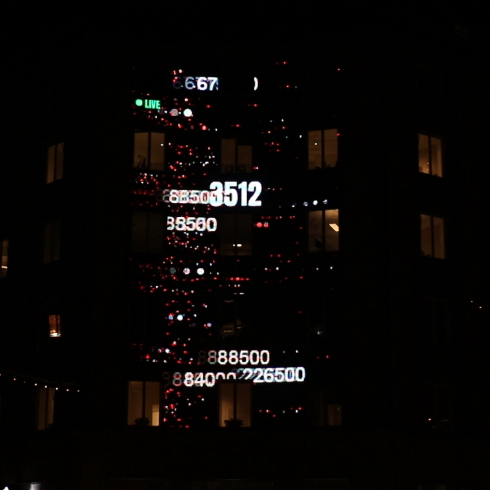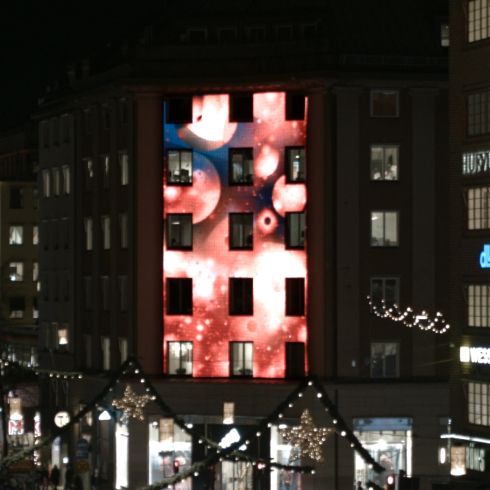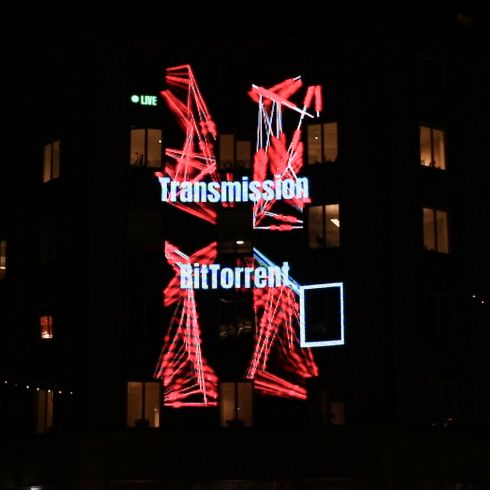STOCKHOLM'S
INTERNET
IN
REAL TIME
5-13
December 2020, every hour, on the hour 40 Kungsgatan, Stockholm, Sweden.
RFC:675:08 is a visual installation at the intersection of science & art for the Nobel Week Lights 2020. The installation unveils the intangible, high-frequency Internet traffic going in and out of Stockholm, in real-time.
At the heart of Stockholm, on the Kungsgatan LED screen, Kungsgatan 40.
From December 5 to 13, 2020
RFC:675:08 runs for 8 minutes, every hour, on the hour, from
6h to 22h


RFC:675:08 receives the Internet traffic that comes in ad out of Stockholm, in real time.
This is an extraordinary amount of data about where Stockholm connects, where it is accessed
from, when it it is connected or for how much data.
In order to let citizens experience this massive, yet invisible traffic that comes in
and out of the city, RFC:675:08 showcases this amazing digital activity in 7 movements.
In the span of an 8-minute visual, light performance, citizens experience the Internet traffic
through the lens of
origin and destination locations world-wide, the speed and frequency, the amplitude and the
protocols.
All these dimensions of Internet communication characterize the key role that Internet plays to
feed news, finances, entertainment, knowledge, science and innovation in Stockholm.
The installation combines information, data and abstract audiovisual representations of
real-time traffic,
creating an emotional bound between Stockholm citizens and the invisible,
continuous connection of the city and the cyber-world. This artwork unveils the data transmitted
from
Stockholm to the world through the internet Transmission Control Protocol and its
interface
to programs or citizens that require its services.
The installation opens and closes with brief presentations and credits, and each movement
is announced with a transition scene.
Below, we provide the intention of each movement's content. The visual presentation for each
movement conveys the idea that the visuals are built on a top of an uninterrupted, intangible
stream of Internet data.

The movements 1 & 2, which open RFC:675:78, focus on the locations that access and that are accessed by Stockholm through the Internet. At this point of the installation, the visitors can see which countries connect to Stockholm and which countries connect to. The country names are displayed as short codes and the trails between a country code and Stockholm visualize a connection and the amount of data for this connection. This is representation of what happens at the moment the movements are displayed.

The movements 3 & 4 focus on the big numbers that characterize Internet traffic: it goes very fast! Visitors experience the speed of Internet connections through a 'rain' of colorful particles that represent Internet packets coming in or going out of Stockholm, as well as through counters that increase at skyrocket speed.

Movements 5 & 6 of RFC:675:08 are the most abstract and poetic representation of Internet traffic. Through pure colorful drops that fall into or outside the LED screen and that accumulate in a cosmical rendering, we vizualize the amplitude of the traffic: each drop's size depends on the amound of data excchanged, and it is massive!

The 7th and last movement of RFC:675:08 reconnects with concrete information and reveals the diversity of languages (a.k.a protocols in Internet jargon) that are used to transmit different kinds of data on Internet. During this movement, the visitors also get a glimpse at the purpose of each language. The aesthetics is also more focused on the networks to amplify the sense of connection and high intensity.
RFC:675:08 is designed and performed by the rethread.art software art collective.
The artwork is named after RFC 675, the official document that layed the foundations of the Internet in 1974, and after the 08 extension referring to Stockholm. The work is thereby anchored to the Internet culture and to the city where the Nobel prizes are awarded and celebrated every year.
Erik Natanael Gustafsson, Thomas Durieux, Jonathan Ramirez Mendoza and Benoit Baudry are supported by the KTH Royal Institute of Technology, the CASTOR center for software research, the NAVET hub for science and art and the Wallenberg Autonomous Systems, Software and AI Program (WASP).
The Internet traffic is broadcasted by Bahnhof
The installation is developed in collaboration with the Nobel Week Lights.